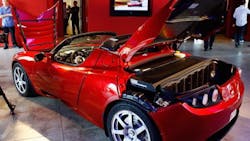Tesla’s Credit Lines Seen Helping Musk Delay Tapping Wall Street
Tesla Motors Inc. Chief Executive Officer Elon Musk, who plans to merge the automaker with SolarCity Corp., surprised investors when he tweeted that it would no longer be necessary for either company to raise equity or borrow money this quarter. That doesn’t mean he’s flush with cash.
What Musk does have is $1.3 billion in credit lines that Tesla can tap to keep the company hobbling along into next year, when analysts expect that he will need to raise as much as $2.5 billion to produce Tesla’s mass-market Model 3 sedan, build out the Gigafactory battery plant and keep cash-burning SolarCity going.
“Everyone kept asking when are they going to do a deal, when are they going to do a deal,” said Ben Kallo, an analyst with Robert W. Baird. “Elon is saying, ‘We have other sources of capital.’ They can tap additional lines of credit.”
Musk, the billionaire founder of SpaceX, may only be buying time before he needs Wall Street’s help. Kallo estimates that Tesla will need to raise $1.5 billion within eight months. On Thursday, Oppenheimer & Co. analyst Colin Rusch said the company will need as much as $12.5 billion by the end of 2018 if it closes the deal with SolarCity. And Goldman Sachs Group Inc. recently downgraded the automaker, citing cash concerns related to the merger.
Opposite Sides
It’s a critical time for Musk, whose plan to sell electric cars that owners can charge at home with solar power has attracted investors who buy into his master vision for clean, sustainable power. What he’s yet to prove is whether his business can sustain itself. On one side, billionaire George Soros’s hedge fund has helped bail out SolarCity, where Musk is the biggest shareholder. On the other side is Jim Chanos, the New York short seller who famously predicted Enron Corp.’s collapse and is now betting against Tesla stock.
Tesla shares fell 0.9% to $199.78 at 1:45 p.m. in New York on Thursday and are down about 9% since before Musk announced the merger proposal in June.
Giving Musk his due, there have been some recent operating improvements, even though neither company is profitable. Tesla topped analysts’ estimates for third-quarter sales, sending shares higher. Meanwhile, SolarCity has been cutting workers and slowing growth to preserve its cash until the merger is done and Tesla can use its balance sheet to raise money for the combined entity.
In the meantime, Palo Alto, Calif.-based Tesla has a $1 billion revolving line of credit. The carmaker paid down a balance of $678 million in July, giving it the full $1 billion if necessary. In addition, Tesla has a $300 million credit line with Deutsche Bank AG to support its automotive leasing business, the company said in a filing Sept. 7.
Tesla said it had $3.25 billion in cash at the end of the second quarter. Some of that comes from 373,000 people putting down $1,000 deposits to reserve a Model 3, whose production is scheduled to start late next year. That’s close to $400 million that will be booked at a future date and which Tesla can tap now if needed.
There have been operational improvements, too. Kallo said Tesla’s capital expenditures may come in under budget. San Mateo, Calif.-based SolarCity is also shifting from leasing solar panels to consumers to selling them, which brings in more immediate cash.
All of that helps, but Tesla will be laying out some big bucks in coming months. As the company gets deeper into developing the Gigafactory and Model 3, its capital expenditures will rise to about $1.7 billion in the final six months of 2017 from $512 million in the first half, according to company filings.
Tesla spokeswoman Alexis Georgeson didn’t immediately return a call and e-mail seeking comment.
Debt Woes
The carmaker is also paying out $441 million to holders of its 2018 senior convertible notes by the end of 2017 and has another $205 million in notes outstanding, the company said in a regulatory filing.
SolarCity has been trying to stave off a default on its debt. It said in its most recent quarterly filing that it was getting closer to violating bond covenants. The company fired 108 employees in August and scaled back guidance for growth for the year to 900 to 1,000 megawatts from 1,000 to 1,100 megawatts.
SolarCity raised $305 million last month with an 18-year loan and by selling future revenue streams to get cash now. The company also issued $124 million in bonds in August at 6.5 percent. With few takers, Musk and his cousins, Lyndon Rive and Peter Rive, bought $100 million of the securities.
That won’t be enough. That’s why the merger has to happen and Musk needs to keep the company going until shareholders vote on the proposal on Nov. 17, said Andrew Bischof, an analyst at Morningstar Inc.
“It’s a challenging standalone story,” Bischof said in an interview. “SolarCity really needs Tesla’s balance sheet.”
About the Author
Bloomberg
Licensed content from Bloomberg, copyright 2016.
